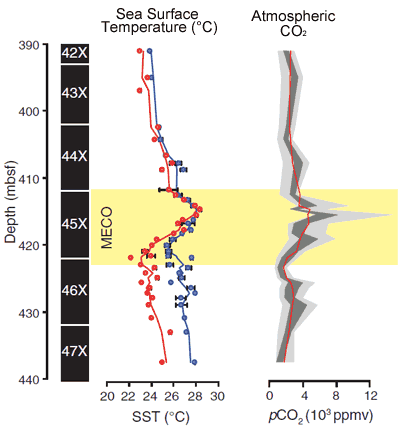Climate change from 40 million years ago shows climate sensitivity to CO2
Posted on 6 November 2010 by John Cook
Around 40 million years ago, sea surface temperatures rose around 5°C in a period called the Middle Eocene Climatic Optimum (MECO). A new study Transient Middle Eocene Atmospheric CO2 and Temperature Variations (Bijl et al 2010) has found atmospheric CO2 was the primary driver of this global warming event. During this period, CO2 levels rose dramatically to 2 to 3 times previous levels. This study gives us further insight into how climate responds to changing CO2 levels and provides evidence for strong climate sensitivity.
The Eocene is a period spanning 56 to 34 million years ago. Over this time, global temperatures showed a long, gradual cooling as the planet moved from a warmer climate to a cooler one (the end of Eocene was marked by Antarctic glaciation). To determine temperature and CO2 changes during the middle Eocene, sedimentary ocean cores were taken from the east coast of Tasmania. The cores contain fossilised microorganisms that provide several independent proxies for temperature. The proxies, or "paleothermometers" as the authors describe them, indicate a warming of the sea surface of around 5°C.
Carbon isotopes in alkenones (produced by algae) serve as a proxy for CO2 levels. Before the MECO warming, CO2 levels were between 600 to 1600 parts per million (note that at these higher CO2 levels, there were no ice sheets in Antarctica). During MECO warming, atmospheric CO2 increased to between 6,400 to 15,000 ppm. The trends in sea surface temperature follow CO2 trends remarkably well.

Figure 1: Sea surface temperatures from two different proxies (red and purple). Atmospheric CO2 levels from algae (light grey band) and phosphate estimates (dark grey band). Yellow shaded area indicates the MECO warming interval.
The advantage of this type of study is it gives us the climate response to changing CO2 levels over long time-scales. This means any temperature changes to rising CO2 will include long-term climate feedbacks like changes in ocean chemistry or changes in vegetation (but in this case, not changes in ice sheets or sea ice as there were no ice sheets during the Middle Eocene). During the Middle Eocene Climatic Optimum, temperatures warmed around 5°C with CO2 increasing by a factor of 2 to 3. This yields a climate sensitivity range of around 2° to 5°C per doubling of atmospheric CO2 (but note that ice feedbacks aren't included). This is broadly consistent with the IPCC climate sensitivity range of 2°C to 4.5°C which is based on a consideration of many estimates of climate sensitivity using instrumental, satellite and proxy data.
One intriguing question remains. Vast amounts of carbon were injected into the atmosphere during the Middle Eocene - where did it all come from? Volcanic outgassing is a possible contributor although it's unlikely it provided all the CO2. It'll be interesting to see what future studies will discover about this distant period.































 Arguments
Arguments























 0
0  0
0






Comments